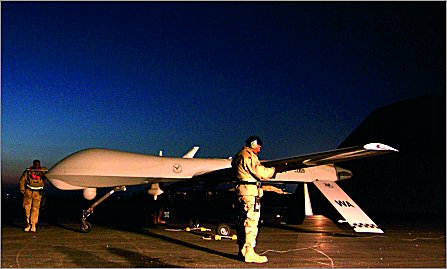General Atomics chairman predicts it will not be long before unmanned aircraft will be a familiar sight in civil skies
In the not-too-distant future, the name of General Atomics Aeronautical Systems (GA-ASI) might not be associated just with military unmanned air vehicles.

The potential for development of a commercial UAV business based on surveillance for oil pipeline transport systems is probably the most feasible alternative application for the technology, says Neal Blue, chairman and chief executive of both GA-ASI and its General Atomics sister company.
“It is likely that at some point within the next quarter century you will have UAVs performing those kinds of missions.”
The enabler, Blue says, will be the achievement of a non-segregated air traffic environment that treats UAVs “for what they are, which is airplanes with the kind of electronic systems and redundancies that are characteristic of the better airplanes. Accordingly, we support the modification of [US Federal Aviation Administration] rules to accommodate these requirements,” he says.
“There was a day in 1903, which is the year the Wright brothers flew, where in the UK it was necessary for a man who wanted to drive an automobile with a reciprocating engine to be preceded by a man carrying a red flag. That was a century ago, so you can imagine that before too long the obvious will become acceptable, which is that these are airplanes and they should be regulated accordingly.”
While the company continues to support work to open US domestic airspace to UAV operations, it will be some time before the company commits resources to work on civilian derivatives of its Predator.
GA-ASI may well monitor new opportunities outside the military sphere, but its activity at present remains tightly focused on delivering the US Army’s new Warrior UAV under the Extended Range Multi-Purpose (ER/MP) programme secured last August, and supporting the US Air Force’s fleet of MQ-1 Predator and MQ-9 Predator B systems. “Our resources are now sufficiently committed to issues of more immediate consequence,” says Blue.
The company is also continuing to work on a new high-altitude, long-endurance variant of its core UAV family, with that larger system nominally designated “Predator C”. A demonstrator aircraft had been expected to fly late in 2005, but has slipped in the wake of the US Army ER/MP win and other programmes supporting the war on terrorism. Current plans now aim at a roll-out during the second half of this year.
Blue, aged 70, has a personal career that has included flying the Andes with his brother Linden in a Piper Tri-Pacer and management of a banana plantation in Nicaragua. As the head of General Atomics group he now controls multiple affiliated companies ranging from nuclear technology development to oil and gas production, uranium mining, aerospace, electromagnetic systems, ground transport and life sciences research sectors.
GA-ASI was set up in 1991 after his company acquired the personnel and assets of the former California-based Leading Systems, which had developed prototypes of what was later to become known as the Gnat 750 UAV. By 1993, that aircraft had evolved into the basic Predator model, with multiple variants entering production since. The larger Predator B derivative appeared in 2001, with US Air Force orders placed that same year.
|
| Civil surveillance uses of MQ-1 Predator are being eyed by GA-ASi |
Orders for the Predator series since 1993 have grown “sort of what you might expect”, Blue says, given the capabilities of the system. The total number of flight hours racked up by production MQ-1s alone has broken the 120,000h barrier, and continues to climb at an average of 4,000h a month.
He says “it would be hard to predict a growth rate” for GA-ASI into the future, “but we anticipate very substantial, compounded growth rates as a result of being able to provide persistent situational awareness at ever improving resolution”.
Homeland security and paramilitary roles are also shaping up as an important focus in the firm’s near- to medium-term plans. “Maybe the easiest quasi-commercial application that you could imagine beyond border and littoral surveillance activities would be protection of pipeline systems. That comes more sharply into focus when you consider the situation in Iraq over the last three years, in particular last year, where as a result of attacks on the production infrastructure, the commercial loss to Iraq exceeded $10 billion,” he says.
“To the extent that you can provide what we would characterise as persistent situation awareness with revisit times amounting to several seconds or minutes, together with a near instantaneous precision-strike capability, one could imagine it being highly effective in protecting oil industry infrastructure assets.”
Blue cautions that in environments not characterised by the level of civil unrest as seen in Iraq, it may be more difficult for UAVs to secure a market foothold. Pipeline surveillance in the USA, he says, is probably not viable. “You are competing against manned aircraft, with lesser endurance, but nevertheless capable of daylight reconnaissance, which provides a cost effective, but more limited, alternative.”
PETER LA FRANCHI / LONDON
Source: Flight International




















